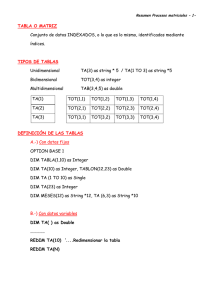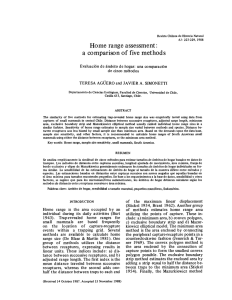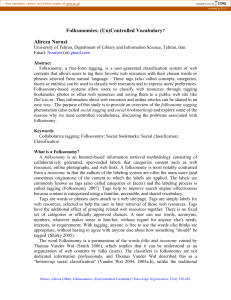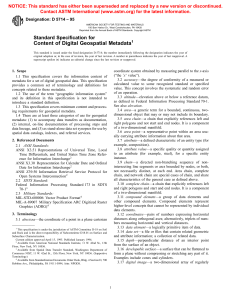Preliminary analysis of historical and recent skipjack tuna tagging
Anuncio
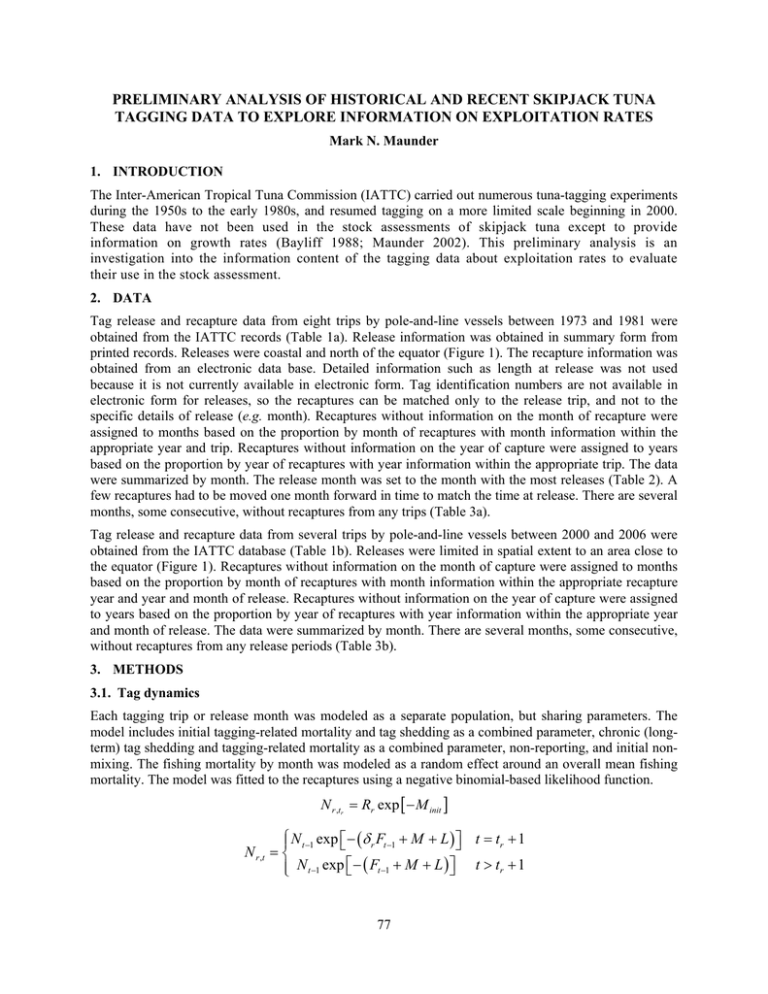
PRELIMINARY ANALYSIS OF HISTORICAL AND RECENT SKIPJACK TUNA TAGGING DATA TO EXPLORE INFORMATION ON EXPLOITATION RATES Mark N. Maunder 1. INTRODUCTION The Inter-American Tropical Tuna Commission (IATTC) carried out numerous tuna-tagging experiments during the 1950s to the early 1980s, and resumed tagging on a more limited scale beginning in 2000. These data have not been used in the stock assessments of skipjack tuna except to provide information on growth rates (Bayliff 1988; Maunder 2002). This preliminary analysis is an investigation into the information content of the tagging data about exploitation rates to evaluate their use in the stock assessment. 2. DATA Tag release and recapture data from eight trips by pole-and-line vessels between 1973 and 1981 were obtained from the IATTC records (Table 1a). Release information was obtained in summary form from printed records. Releases were coastal and north of the equator (Figure 1). The recapture information was obtained from an electronic data base. Detailed information such as length at release was not used because it is not currently available in electronic form. Tag identification numbers are not available in electronic form for releases, so the recaptures can be matched only to the release trip, and not to the specific details of release (e.g. month). Recaptures without information on the month of recapture were assigned to months based on the proportion by month of recaptures with month information within the appropriate year and trip. Recaptures without information on the year of capture were assigned to years based on the proportion by year of recaptures with year information within the appropriate trip. The data were summarized by month. The release month was set to the month with the most releases (Table 2). A few recaptures had to be moved one month forward in time to match the time at release. There are several months, some consecutive, without recaptures from any trips (Table 3a). Tag release and recapture data from several trips by pole-and-line vessels between 2000 and 2006 were obtained from the IATTC database (Table 1b). Releases were limited in spatial extent to an area close to the equator (Figure 1). Recaptures without information on the month of capture were assigned to months based on the proportion by month of recaptures with month information within the appropriate recapture year and year and month of release. Recaptures without information on the year of capture were assigned to years based on the proportion by year of recaptures with year information within the appropriate year and month of release. The data were summarized by month. There are several months, some consecutive, without recaptures from any release periods (Table 3b). 3. METHODS 3.1. Tag dynamics Each tagging trip or release month was modeled as a separate population, but sharing parameters. The model includes initial tagging-related mortality and tag shedding as a combined parameter, chronic (longterm) tag shedding and tagging-related mortality as a combined parameter, non-reporting, and initial nonmixing. The fishing mortality by month was modeled as a random effect around an overall mean fishing mortality. The model was fitted to the recaptures using a negative binomial-based likelihood function. = N r ,tr Rr exp [ − M init ] N t −1 exp − (δ r Ft −1 + M + L ) t =tr + 1 N r ,t = N t −1 exp − ( Ft −1 + M + L ) t > tr + 1 77 δ r Ft δ F + M + L 1 − exp − (δ r Ft + M + L ) r t p r ,t = Ft 1 − exp − ( Ft + M + L ) Ft + M + L ( ( ) ) t= tr t > tr C= N r ,t pr ,t (1 − exp [ −τ ] ) r ,t Ft = µ F exp [ε tσ ] ε t ~ N ( 0,1) where Nr,t : number of tagged fish alive from release r at time t Rr : number of releases in release group r tr : time of release r M: natural mortality, assumed constant over time and common among release groups Cr,t : predicted reported recaptures in time t from release group r Ft : fishing mortality for time t, assumed common among release groups Minit : initial tagging-related mortality and tag shedding δr : fishing mortality multiplier in the time period of release to deal with non-mixing L: chronic (long-term) tag shedding and tag-related mortality τ: parameter representing reporting rate If effort data are available, fishing mortality can be made proportional to fishing effort Ft = qEt exp [ε tσ ] where q is the catchability coefficient. 3.2. Likelihood The likelihood function is based on the negative binomial (NB) θ Γ (θ + y ) θ Cr ,t q ( y r ,t | C r ,t , θ ) = Γ (θ ) y ! θ + Cr ,t θ + Cr ,t y where C and θ are the mean and size parameters, respectively. Formally y = 0, 1, 2,…, but our data have fractional recoveries due to unknown month and year or recapture and reporting rate calculation. As 1/θ approaches zero, the NB distribution is reduced to the Poisson distribution. The total likelihood is just the product of the likelihood for all the individual recaptures: q ( y | C, θ ) = ∏ q ( yr ,t | Cr ,t , θ ) r ,t 4. APPLICATION Maunder and Harley (2005) used an age-specific schedule for natural mortality. Natural mortality is very 78 high for young skipjack, followed by a decrease, and then increases. Based on mid-sized skipjack (45-65 cm) in Maunder and Harley (2005) and the values used in historical yield-per-recruit analyses, we assume a natural mortality of 0.15 per month. Bayliff and Mobrand (1972) estimated tag shedding for yellowfin tuna from double-tagging experiments. “The Type-1 shedding, which occurs immediately after release of the fish, is about 10 percent. The Type2 shedding is assumed to be constant throughout the life of the fish after tagging; it occurs at an instantaneous rate of about 0.278 per year.” Based on these estimates, the following parameters are set to represent tag shedding M init = − ln [1 − 0.1] = 0.105 = L 0.278 = / 12 0.023 These values do not include tag-related mortality. Chronic tag-related mortality is thought to be low, but initial tag-related mortality could be substantial, particularly for skipjack. Maunder et al. (2007) estimated immediate tag shedding of 3% and continuous tag shedding of 0.1y-1, for skipjack, yellowfin, and bigeye tuna combined, but tag shedding may have been influenced by poorly-trained taggers. Hampton (2000) assumed a combined instantaneous tag shedding and instantaneous non-reporting of tags and used an estimate of 0.45 for the three species of tunas, and Type-2 tag shedding of 0.0023·month–1, based on Hampton (1997). He assumed tagging-related mortality was insignificant. Hoyle (2011) found that recovery rates differed substantially among taggers, suggesting that tagger-related differences in the tagging and release processes can translate into substantial variability in survival rates. He assumed the tagging-related mortality rate for expert taggers was 7%, with 95% confidence intervals (CI) from 3% to 16%. He also estimated the additional (tag shedding + mortality) effect for the average tagger relative to the best tagger as 11%. We believe the reporting rate for these tagging studies to be relatively high. Data presented in Bayliff (1971) indicate that the reporting rate was around 91%, but this estimate is based on limited data. Based on this estimate, the following parameter is set to represent reporting rate = τ -ln(-(0.91-1)) = 2.408 Maunder et al. (2007) estimated reporting rates of 0.5 to 0.7 for skipjack tuna from tag-seeding experiments, with reporting rate decreasing with size. Hoyle (2011) found low reporting rates of around 50%. The tags were modeled for only 18 months to reduce the calculations and avoid biases that might be caused by fitting to a long series of zero observed recoveries. The model was run with and without effort data to determine if they explained additional variation in the recaptures. The effort data are the number of days fished, using either floating-object or unassociated purse-seine sets. The effort used for the historic tag data was from IATTC length-composition measurement areas 1, 2, 4, and 8, and for the recent tag data from IATTC length-composition measurement areas 7 and 9. These areas relate approximately to the areas of release, and are two of the areas proposed for sub-stocks in future skipjack stock assessments. 5. RESULTS The model fits the recaptures reasonably well (Figure 2), as expected, since temporal variation in fishing mortality is modeled and tags do not remain in the population for long. The fishing mortality is highly variable over time (Figure 3), and the standard deviation of the fishing mortality temporal deviate on the logarithmic scale was 1.36 for the historic data and 1.06 for the recent data. The fishing mortality scaling parameter for the month at release to adjust for non-mixing was substantially above one for most trips for the historic data, but not for the recent data (Table 5). Some of the time periods did not have recaptures, so there was little or no information on fishing mortality for those time periods (Figure 3). The maximum monthly fishing mortality, not including the non-mixing scalar, was 0.65 for the historic data and 0.20 for the recent data. μF was estimated as 0.021 and 0.016, which has no lognormal bias correction, and the 79 mean calculated over the whole time is 0.044 and 0.024 for historic and recent data, respectively. The mean calculated only for time periods where the temporal deviate was not zero (i.e. time periods for which information in the recaptures exists) is higher at 0.049 and 0.025. There is a large amount of uncertainty in the estimates of fishing mortality (Figure 4) with coefficients of variation (CVs) around 40% to 140%. The results are similar when the fishing mortality is proportional to effort. For the historic tag data the negative log likelihood increases to 381.1 from 372.7 when including the effort data, indicating that the fishing effort data does not relate to fishing mortality experienced by these tagged skipjack. For the recent tag data the negative log likelihood decreases to 150.6 from 163.0 when including the effort data, indicating that the fishing effort data relates somewhat to fishing mortality experienced by these tagged skipjack. However, the standard deviation of the random effect distribution for the fishing mortality deviates only reduces to 0.80 from 1.06, indicating that there is still a lot of unexplained variation in the fishing mortality on these tagged skipjack. 6. DISCUSSION There is a large amount of temporal variability and uncertainty in the estimates of fishing mortality based on the tagging data. Adding effort data did not improve the analysis substantially. This analysis suggests that it is unlikely that the historical tagging data will provide a substantial amount of information on fishing mortality to improve the skipjack stock assessment. However, there are spatial differences in some of the historic tagging trips and given the possibility of limited skipjack movement and local effects of fishing effort, further refinement to the analysis could be made by spatial segregation of the data and addition of catch data. Catch data will provide further information on the temporal variability in fishing mortality allowing the tagging data to inform the absolute levels of fishing mortality. The planned skipjack assessment, which will simultaneously analyze the catch, length composition and tagging data, will use spatial structure. Under the assumption that tag shedding, tagging-related mortality, and reporting rates are the same for the historic and recent data, the analysis indicates that recent fishing mortality rates in the area of the recent tagging are lower than the historic fishing mortality rates in the areas of the historic tagging. However, it is likely that reporting rate differs, and the other quantities may as well. There appears to be a substantial amount of movement indicated by the recent tag data (Figure 5) but the true extent of the movement is unknown due to a large proportion of the recapture information being incorrect, due to misreporting of the vessel name and/or well numbers from which tagged fish were recovered. Therefore, it is unclear if the assumption that all tags are recaptured in the area in which they were released is valid or how violation of this assumption will bias the stock assessment results. Entering detailed information about individual releases for the historic data would allow a more detailed analysis of the information and facilitate its integration into the stock assessment model. However, a wellplanned and executed comprehensive tagging study is probably the only way to provide an adequate stock assessment for skipjack tuna in the EPO. ACKNOWLEDGEMENTS William Bayliff provided the historic tagging data. Kurt Schaefer and Dan Fuller provided the recent tagging data. William Bayliff and Patrick Tomlinson provided insight into the fisheries and data. REFERENCES Bayliff, W.H. 1988. Growth of skipjack, Katsuwonus pelamis, and yellowfin, Thunnus albacares, tunas in the eastern Pacific Ocean, as estimated from tagging data. Inter-American Tropical Tuna Commission, Bulletin, 19 (4): 307-385. Bayliff, W.H. and Mobrand, L.M. 1972. Estimates of the rates of shedding of dart tags from yellowfin tuna. Inter-American Tropical Tuna Commission, Bulletin, 15 (5): 441-462. 80 Hoyle, S.D. 2011. Tag reporting rate prior distributions for the 2011 bigeye, yellowfin, and skipjack stock assessments. WCPFC-SC7-2011/SA-IP-10. Maunder, M.N. 2002. Growth of skipjack tuna (Katsuwonus pelamis) in the eastern Pacific Ocean, as estimated from tagging data. Inter-American Tropical Tuna Commission Bulletin, 22(2): 93-131. Maunder, M.N. and Harley, S.J. 2005. Status of skipjack tuna in the eastern Pacific Ocean in 2003 and outlook for 2004. Inter-Amer. Trop. Tuna Comm., Stock Assessment Report, 5. Maunder, M.N., K. Schaefer, D. Fuller, and E. Altamirano Nieto. 2007. Estimating tag reporting and tag shedding for tunas in the EPO. In Maunder, M.N. (compiler) Report of the Inter-American Tropical Tuna Commission Workshop on Using Tagging Data for Fisheries Stock Assessment and Management. http://www.iattc.org/PDFFiles2/Tagging-WS-Oct-2007-Report-ENG.pdf. TABLE 1a. Number of releases and recaptures, by tagging trip, for the historic data. TABLA 1a. Número de liberaciones de recapturas, por viaje de marcado, para los datos históricos. Trip Viaje 1070 1075 1078 1079 1082 1084 1089 1095 Release year Año de liberación 1973 1975 1975 1976 1976 1979 1980 1981 Releases Recaptures Liberaciones Recapturas 1937 527 1035 285 1803 887 4180 1239 8455 5543 2507 606 1818 102 2203 417 81 Recapture rate Tasa de recaptura 0.27 0.28 0.49 0.30 0.66 0.24 0.06 0.19 TABLE 1b. Number of releases and recaptures, by date, for the recent data. TABLA 1b. Número de liberaciones de recapturas, por fecha, para los datos recientes. Year Month Releases Recaptures Año 2000 Mes 4 5 3 4 5 3 4 5 3 4 5 4 3 4 Liberaciones 131 1105 1 210 38 21 11 116 178 587 146 381 43 551 Recapturas 18.3 244.7 0.0 26.0 5.0 1.0 4.0 17.0 39.0 108.0 11.0 32.0 7.0 68.0 2002 2003 2004 2005 2006 Recapture rate Tasa de recaptura 0.14 0.22 0.00 0.12 0.13 0.05 0.36 0.15 0.22 0.18 0.08 0.08 0.16 0.12 TABLE 2. Number of releases, by trip and month of release, for the historic data. TABLA 2. Número de liberaciones, por viaje y mes de liberación, para los datos históricos. Months since May 1973 Meses desde mayo de 1973 0 1 2 25 26 29 30 37 41 70 71 72 83 94 95 96 1070 1075 1070 68 1688 181 1075 Trip number 1078 1079 1082 1084 Número de viaje 1078 1079 1082 1084 1089 1095 1089 1095 257 778 302 1501 4180 8455 3 2502 2 1818 424 1759 20 82 TABLE 3a. Recaptures used in the model after adjusting for unknown month and year and recaptures before the assumed month of release for the historic data. TABLA 3a. Recapturas usadas en el modelo tras ajustar por mes y año desconocidos, y recapturas antes del mes de liberación supuesto, para los datos históricos. Year Month Año Mes 1973 1974 1975 1976 1976 1070 1075 1078 Trip number 1079 1082 Número de viaje 1079 1082 1070 1075 1078 6 78.20 7 127.65 8 51.75 9 71.30 10 120.75 11 56.35 12 13.80 1 1.44 2 1.44 3 4 1.44 5 6 1.44 7 8 1.44 9 10 11 12 1 2 3 4 5 6 7 69.42 8 175.51 9 13.10 10 2.62 11 3.93 795.05 12 2.62 18.38 1 3.14 15.32 2 2.10 25.54 3 1.05 2.55 4 1.05 2.55 5 10.21 6 1.05 2.55 280.94 7 2.10 6.38 477.60 8 1.05 28.09 9 2.10 5.11 206.49 10 3.14 126.42 4103.21 11 1.28 42.14 1187.39 83 1084 1089 1095 1084 1089 1095 Year Month Año Mes 1977 1977 1978 1979 1980 12 1 2 3 4 5 6 7 8 9 10 11 12 1 2 3 4 5 6 7 8 9 10 11 12 1 2 3 4 5 6 7 8 9 10 11 12 1 2 3 4 5 6 7 8 9 1070 1075 1070 1075 1.05 Trip number 1079 1082 Número de viaje 1078 1079 1082 16.86 177.15 27.02 39.42 14.05 25.08 2.16 2.16 1.19 1.08 4.78 5.40 1.19 1.04 4.32 1.08 2.16 2.39 1078 1084 1089 1095 1084 1089 1095 1.19 1.02 1.04 25.55 123.91 283.60 63.87 56.21 25.55 16.61 2.55 5.11 1.01 14.18 2.36 8.27 33.08 9.45 1.01 8.27 84 Year Month Año Mes 1981 1981 1982 1070 1075 1078 1070 1075 1078 Trip number 1079 1082 Número de viaje 1079 1082 10 11 12 1 2 3 4 5 6 7 8 9 10 11 12 1 2 3 4 5 6 7 8 1084 1089 1095 1089 10.63 4.73 4.73 1.01 2.10 1095 1084 2.10 123.51 2.10 162.85 71.04 19.67 5.46 6.56 8.74 6.56 2.19 4.37 2.42 1.21 1.21 1.21 85 TABLE 3b. Recaptures used in the model after adjusting for unknown month and year, for the recent data. TABLA 3b. Recapturas usadas en el modelo tras ajustar por mes y año desconocidos, para los datos recientes. Year Año 2000 2001 2002 2002 2003 Year Month Año Mes 4 5 6 7 8 9 10 11 12 1 2 3 4 5 6 7 8 9 10 11 12 1 2 3 4 5 6 7 8 9 10 11 12 1 2 3 4 5 6 7 8 9 10 2000 5 4 3 2000 5 4 1.02 11.17 164.50 5.08 61.94 1.02 3 2002 4 2002 4 5 5 3 3 2003 4 2003 4 5 5 8.12 4.06 2.03 1.02 3.00 12.00 2.00 6.00 2.00 1.00 3.00 1.00 1.00 3.00 1.00 1.00 1.02 2.03 4.00 6.00 1.00 2.00 3.00 86 3 3 2004 4 2004 4 5 5 2005 4 2005 4 2006 3 4 2006 3 4 Year Año 2004 2005 2006 2006 2007 Year Month Año Mes 11 12 1 2 3 4 5 6 7 8 9 10 11 12 1 2 3 4 5 6 7 8 9 10 11 12 1 2 3 4 5 6 7 8 9 10 11 12 1 2 3 4 5 6 7 8 9 2000 5 4 3 2000 4 5 3 2002 4 2002 4 5 5 3 3 2003 4 2003 4 5 5 3 3 2004 4 2004 4 2.00 1.02 20.00 70.30 13.00 21.40 1.00 1.02 1.02 1.00 3.06 2.00 3.06 3.06 3.06 1.02 5 5 2005 4 2005 4 2006 3 4 2006 3 4 1.22 4.89 1.22 2.44 1.22 1.00 3.00 8.00 6.00 1.00 4.00 6.00 2.00 1.00 1.00 4.32 6.48 3.50 17.27 9.71 2.16 1.17 10.79 3.24 2.33 5.40 3.24 1.08 1.08 1.08 1.08 1.08 87 Year Año Year Month Año Mes 10 11 12 2000 5 4 3 2000 4 5 3 2002 4 2002 4 5 5 3 3 88 2003 4 2003 4 5 5 3 3 2004 4 2004 4 5 5 2005 4 2005 4 2006 3 4 2006 3 4 TABLE 4a. Effort data (days fished) used in the analysis of the historic data. TABLA 4a. Datos de esfuerzo (días de pesca) usados en el análisis de los datos históricos. Year Año 1973 1974 1975 1976 Month Effort Mes Esfuerzo 6 596 7 1111 8 1116 9 405 10 374 11 234 12 242 1 747 2 1033 3 979 4 803 5 657 6 796 7 928 8 751 9 449 10 483 11 494 12 211 1 961 2 1017 3 838 4 960 5 1485 6 1051 7 1079 8 753 9 569 10 492 11 417 12 224 1 545 2 686 3 1086 4 1069 5 746 6 1231 7 1029 8 782 9 1099 10 653 11 614 12 182 Year Año 1977 1978 1979 Month Effort Mes Esfuerzo 1 574 2 846 3 531 4 585 5 1033 6 1482 7 916 8 947 9 820 10 549 11 519 12 357 1 391 2 850 3 872 4 1126 5 727 6 1017 7 1356 8 902 9 507 10 611 11 661 12 272 1 533 2 1214 3 1520 4 1671 5 1459 6 1432 7 1118 8 1144 9 1016 10 701 11 906 12 425 Year Año 1980 1981 1982 1983 89 Month Effort Mes Esfuerzo 1 907 2 1494 3 1478 4 1421 5 1793 6 2033 7 894 8 764 9 1030 10 808 11 653 12 549 1 725 2 961 3 1357 4 1628 5 1175 6 1091 7 1129 8 1039 9 1236 10 1122 11 1173 12 426 1 421 2 678 3 1251 4 1253 5 750 6 666 7 783 8 972 9 826 10 858 11 691 12 371 1 263 2 384 3 500 4 729 TABLE 4b. Effort data (days fished) used in the analysis of the recent data. TABLA 4b. Datos de esfuerzo (días de pesca) usados en el análisis de los datos recientes. Year Año 2000 2001 2002 Month Mes 4 5 6 7 8 9 10 11 12 1 2 3 4 5 6 7 8 9 10 11 12 1 2 3 4 5 6 7 8 9 10 Effort Esfuerzo 1099 671 961 755 557 536 316 447 766 897 251 437 560 531 875 635 518 518 636 746 752 375 423 511 304 452 857 681 620 662 793 Year Año 2002 2003 2004 2005 Month Mes 11 12 1 2 3 4 5 6 7 8 9 10 11 12 1 2 3 4 5 6 7 8 9 10 11 12 1 2 3 4 5 90 Effort Esfuerzo 845 114 377 231 234 346 295 519 747 1009 925 1127 1163 708 407 370 471 397 989 977 644 249 814 1452 1203 726 606 330 169 265 627 Year Año 2005 2006 2007 Month Mes 6 7 8 9 10 11 12 1 2 3 4 5 6 7 8 9 10 11 12 1 2 3 4 5 6 7 8 9 10 Effort Esfuerzo 1008 840 115 630 1165 976 634 569 501 405 708 493 776 1389 407 1234 1588 1179 955 755 339 310 760 1051 1070 1271 239 576 943 TABLE 5. Estimates of Finit, the fishing mortality scaling parameter for the month at release to adjust for non-mixing. a) historic data and b) recent data. TABLA 5. Estimaciones de Finit, el parámetro de escala de la mortalidad por pesca para el mes de liberación para ajustar por ausencia de mezcla. Datos a) históricos, y b) recientes. a. Trip 1070 1075 1078 1079 1082 1084 1089 1095 Finit 2.68 4.95 50.46 3.91 4.62 0.65 1.61 6.10 b. Year 2000 2002 2003 2004 Month 4 5 3 4 5 3 4 5 3 Finit 0.51 2.08 0.01 0.01 1.76 0.01 34.77 1.94 0.01 91 4 2005 5 0.14 0.06 2006 4 3 4 0.31 0.01 1.04 FIGURE 1. Release positions of the historic (top) and recent (bottom) releases FIGURA 1. Posiciones de liberación de las liberaciones históricas (arriba) y recientes (abajo). 92 FIGURE 2a. Fit of the model to the recapture data, by trip, for the historic data. Month 1 = June 1973. FIGURA 2a. Ajuste del modelo a los datos de recaptura, por viaje, para los datos históricos. Mes 1 = junio de 1973. 93 FIGURE 2b. Fit of the model to the recapture data, by month, for the recent data. Month 1 = April 2000. FIGURA 2b. Ajuste del modelo a los datos de recaptura, por mes, para los datos recientes. Mes 1 = abril de 2000. 94 FIGURE 2b. (continued). FIGURA 2b. (continuación). 95 FIGURE 3a. Estimates of the monthly fishing mortality (F) (upper panel) and the associated temporal deviate (lower panel) for the historic data. Month 1 = June 1973. FIGURA 3a. Estimaciones de la mortalidad por pesca (F) mensual (panel superior) y el desvío temporal asociado (panel inferior) para los datos históricos. Mes 1 = junio de 1973. 96 FIGURE 3b. Estimates of the monthly fishing mortality (F) (upper panel) and the associated temporal deviate (lower panel) for the historic data. Month 1 = April 2000. FIGURA 3b. Estimaciones de la mortalidad por pesca (F) mensual (panel superior) y el desvío temporal asociado (panel inferior) para los datos recientes. Mes 1 = abril de 2000. 97 FIGURE 4a. Estimates of fishing mortality (F), with 95% confidence intervals, for the historic data. Month 1 = June 1973. FIGURA 4a. Estimaciones de la mortalidad por pesca (F), con intervalos de confianza de 95%, para los datos históricos. Mes 1 = junio de 1973. 98 FIGURE 4b. Estimates of fishing mortality (F), with 95% confidence intervals, for the recent data. Month 1 = April 2000. FIGURA 4b. Estimaciones de la mortalidad por pesca (F), con intervalos de confianza de 95%, para los datos recientes. Mes 1 = abril de 2000. 99 FIGURE 5a. Release (top) and recapture (bottom) positions of the historic tags. FIGURA 5a. Posiciones de liberación (arriba) y recaptura (abajo) de las marcas históricas. 100 FIGURE 5b. Release (top) and recapture (bottom) positions of the recent tags FIGURA 5b. Posiciones de liberación (arriba) y recaptura (abajo) de las marcas recientes. 101
